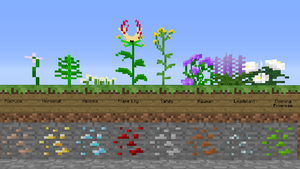Prospecting is a big part of the altered game play in Harder Ores, making the player want to explore the surface world in order to find resources, rather than blindly digging around until stumbling into them by accident. This makes the search for ores intentional, predictable, and engaging.
Locating Ore

There are three primary methods to locating ore.
- Exploring the surface, looking for various plants that indicate the presence of ore in a region. Each ore has its own unique plant that indicates a nearby vein (seen at the right or in the table at the bottom of the page). These patches are relatively rare and will not mark every vein of ore. They are also very imprecise, spawning somewhere within 30 blocks (measured along the X and Z directions) of the vein, regardless of how far underground it is.
- Bonemeal. This method is best used after locating one of these natural occurring plant clusters in order to narrow down your search before you start digging. By grinding bones into bonemeal and using it to grow flowers you will occasionally get some of the flowers shown at the right if their associated ore is nearby. You will get more of them and get them more often, the more ore is available in the chunk, as far down as about 48 blocks. If the primary ore cluster is farther than 32 blocks down, the flower occurance rate will drop off quickly (technical details: every ore block in every 8 block vertical slice of each chunk is counted where one third of the total is saved in the next slice up, the remaining two thirds in the actual slice).
- The sluice has a much wider search area, but less depth, than bonemeal and will reduce the amount of ore in the local soil to produce nuggets and tiny dust piles (technical details: the ore blocks themselves are unaffected, but the data structure used to track ore presence has its values depleted, simulating the filtering and collecting of the ambient ore flakes: you can only pan a river so much afterall). So while the sluice can generate some early ore production, it isn't long-term viable and can make locating the vein with bonemeal harder in the future.
Once you have located an area that likely contains ore, you have to go mining in order to find the vein itself. Once found, it should supply you with as much material as you are likely to use for some time, and will likely support several players in SMP, even with the high demands of various tech mods. Due to the non-homogynous nature of the ore distribution and the relative rarity, it may even be possible for a server to create a small, viable, economy where one player or group of players set up a mining and refining outpost near one vein and another player or group sets up near a different ore vein.
Additionally, veins tend to be found easily by exploring caves, so if during your excavation you find a cave (or hear monsters or bats nearby), take a look around, the vein may have passed through, and it's a lot easier to spelunk than to excavate.